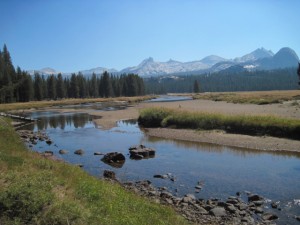
Hetch Hetchy Reservoir
The more recent story of the Tuolumne River began in the early 1900s- when San Francisco believed it would not be able to meet its growing population’s water needs with local sources alone.
San Francisco looked at a few different far-off rivers for a new source of water. One choice was the Mokelumne River, which is now the source of the East Bay’s water. Another, was the Tuolumne River. In pristine Yosemite National Park, the purity of the water would be assured and granite canyons offered a perfect place to store water.
One valley became the source of great controversy- Hetch Hetchy. Most San Franciscans know the story. Of the great battle John Muir waged against a reservoir being built in a valley Muir said was as beautiful as famous Yosemite Valley. At the height of the battle, Muir said, “Dam Hetch Hetchy! As well dam for water-tanks the people’s cathedrals and churches, for no holier temple has ever been consecrated by the heart of man.” Muir lost the fight. And in 1913, Congress passed the Raker Act, giving San Francisco the right to build O’Shaughnessy Dam and flood Hetch Hetchy Valley.
The path of the Tuolumne in recent times and our drinking water
The system of reservoirs and pipelines that was built on the Tuolumne changed the flow of the river entirely. At the same time it has enabled San Francisco and the Bay Area to grow. Besides supplying San Francisco with 85 percent of its water, the river also provides the city with revenue from the sale of hydropower.
Engineered to bring water from Hetch Hetchy 170 miles to San Francisco, the system was designed to be almost entirely gravity-fed. Miles of tunnels were cut through rock and mountain so that water could be carried from the mountains to the city using gravity instead of electricity. By contrast, water that flows down the California Aqueduct to Southern California takes an astronomical amount of energy to be pumped over the Tehachapi Mountains at the southern end of the Central Valley. And more electricity almost always means more greenhouse gas emissions.
On its new course, the Tuolumne is still born high up in the Sierras, running through Tuolumne Meadows, it drops down through the Grand Canyon of the Tuolumne. It then pours into Hetch Hetchy Reservoir, where a highly coordinated effort dictates how much water will be stored in Hetchy and how much will go to the city.
Some of the water is diverted to make hydropower and most will continue its journey through a complex system of reservoirs and pipelines that make their way down the foothills and over the Central Valley. The Tuolumne River itself continues after Hetch Hetchy until it hits its next major road block- Don Pedro Lake, a reservoir created behind New Don Pedro Dam. It then continues two miles downstream where it meets another dam at La Grange.
After the La Grange dam, the Tuolumne River continues on its historical route, unimpeded till it meets with the San Joaquin River. Only it has got a lot less water in it. Our demands on the river are great. Besides San Francisco and the Bay Area, the Tuolumne supplies water to the Turlock and Modesto Irrigation Districts.


That’s quite a journey. The Tuolumne must be awfully tired.